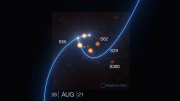
The Breakthrough Listen Investigation for Periodic Spectral Signals (BLIPSS) is using pioneering techniques to search for extraterrestrial intelligence (SETI) within the Milky Way. The team developed software based on a Fast Folding Algorithm (FFA), a search method that offers enhanced sensitivity to periodic sequences of narrow pulses. This approach is aimed at detecting repeating patterns in signals emanating from our galaxy’s core. The algorithm has been tested on known pulsars and will be used to scan a large dataset of the Galactic Center. Credit: Breakthrough Listen / Danielle Futselaar
BLIPSS is using new software based on a Fast Folding Algorithm (FFA) to search for extraterrestrial intelligence (SETI) in the Milky Way. The software can detect repeating patterns in signals, potentially indicating the presence of extraterrestrial technology in the galaxy’s densely populated central region.
The Breakthrough Listen Investigation for Periodic Spectral Signals (BLIPSS), led by Akshay Suresh, Cornell doctoral candidate in astronomy, is pioneering a search for periodic signals emanating from the core of our galaxy, the Milky Way. The research aims to detect repetitive patterns, a way to search for extraterrestrial intelligence (SETI) within our cosmic neighborhood.
The researchers developed software based on a Fast Folding Algorithm (FFA), an efficient search method offering enhanced sensitivity to periodic sequences of narrow pulses. Their paper, “A 4–8 GHz Galactic Center Search for Periodic Technosignatures,” was published on May 30 in The Astronomical Journal.
Pulsars — rapidly rotating neutron stars that sweep beams of radio energy across the Earth — are natural astrophysical objects that generate periodic signals but humans also use directed periodic transmissions for a variety of applications, including radar. Such signals would be a good way to get someone’s attention across interstellar space, standing out from the background of non-periodic signals, as well as using much less energy than a transmitter that is broadcasting continuously.
“BLIPSS is an example of cutting-edge software as a science multiplier for SETI,” said Suresh. “Our study introduces to SETI, for the first time, the Fast Folding Algorithm; our open-source software utilizes an FFA to crunch over 1.5 million time series for periodic signals in roughly 30 minutes.”
BLIPSS is a collaborative effort between Cornell, the SETI Institute, and Breakthrough Listen. The project significantly enhances the probability of capturing evidence of extraterrestrial technology by focusing on the central region of the Milky Way, known for its dense concentration of stars and potentially habitable exoplanets. The center of the Milky Way would also be an ideal place for aliens to place a beacon to contact large swaths of the Galaxy.
The team tested their algorithm on known pulsars and were able to detect periodic emission as expected. They then turned to a larger dataset of scans of the Galactic Center undertaken using the Breakthrough Listen instrument on the 100-meter Green Bank Telescope (GBT) in West Virginia. In contrast to pulsars, which emit across a wide swath of radio frequencies, BLIPSS looked for repeating signals in a narrower range of frequencies, covering less than one-tenth of the width of an average FM radio station.
“The combination of these relatively narrow bandwidths with periodic patterns could be indicative of deliberate technological activities of intelligent civilizations,” said co-author Steve Croft, Breakthrough Listen project scientist. “Breakthrough Listen captures huge volumes of data, and Akshay’s technique provides a new method to help us search that haystack for needles that could provide tantalizing evidence of advanced extraterrestrial life forms.”
“Until now, radio SETI has primarily dedicated its efforts to the search for continuous signals,” said co-author Vishal Gajjar, a SETI Institute astronomer. “Our study sheds light on the remarkable energy efficiency of a train of pulses as a means of interstellar communication across vast distances. Notably, this study marks the first-ever comprehensive endeavor to conduct in-depth searches for these signals.”
Reference: “A 4–8 GHz Galactic Center Search for Periodic Technosignatures” by Akshay Suresh, Vishal Gajjar, Pranav Nagarajan, Sofia Z. Sheikh, Andrew P. V. Siemion, Matt Lebofsky, David H. E. MacMahon, Danny C. Price and Steve Croft, 30 May 2023, The Astronomical Journal.
DOI: 10.3847/1538-3881/acccf0









“The project significantly enhances the probability of capturing evidence of extraterrestrial technology by focusing on the central region of the Milky Way, known for its dense concentration of stars and potentially habitable exoplanets.”
My understanding was that the galaxy’s center was not so life-friendly due to high-energy radiation.
And so far we’ve not seen or heard anything….yup keep settling in on the “science”